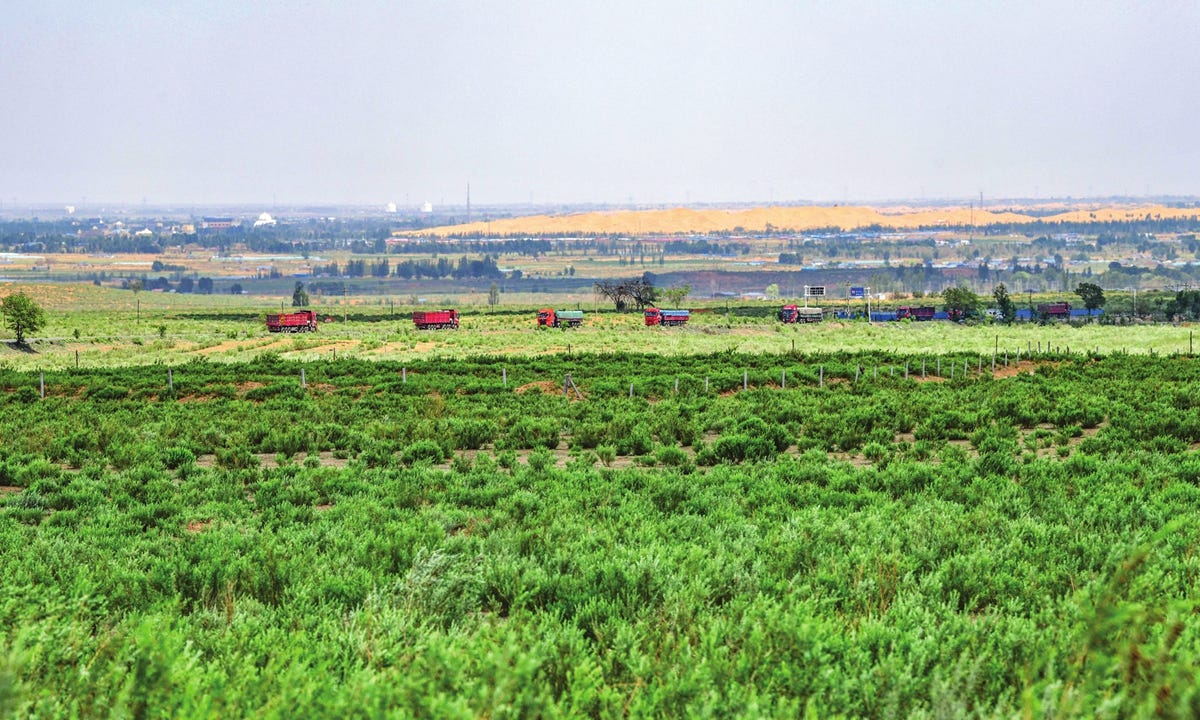The Great Green Wall of China, or, more officially, the Three-North Shelterbelt Forest Program (TSFP), is the world’s largest forest program, stretching a staggering 4,400km east to west across 13 northern, northwestern, and northeastern Chinese provinces. The TSFP is a key component of China’s long-term strategy to fight climate change and desertification and to build an ecological civilization. So, what is the Great Green Wall doing, and is it working?

Desertification – A Growing Problem
According to the United Nations Convention to Combat Desertification (UNCCD), the world has lost something like 33% of arable land to desertification since the 1980s. This is a serious issue as the growth of deserts into more habitable land is, through a process of soil erosion, water depletion, and vegetation loss, increasing food and water insecurity for hundreds of millions of people across the globe.
China was particularly vulnerable to the forces of desertification as around 25% of the Chinese landmass was already desert, and by the end of the 1970s, 27.4% of the land had undergone some form of desertification, affecting nearly 400 million people. Faced with the growing problem of desertification, the Chinese government acted in 1978 by beginning work on the Great Green Wall of China, or TSFP. In 1983 the Chinese government would enshrine the TSFP as one of China’s basic national strategies.
What Is the Great Green Wall of China?
The Great Green Wall is the world’s largest tree-planting program. Since the beginning of the project, some 32 million hectares of trees have been planted across the north of China, acting as a barrier against the encroaching desert. But the TSFP isn’t just a tree planting program: since 1978 some 85 million hectares of grassland has been restored, and 30 million hectares of farmland has benefited from the work done on the TSFP.
The TSFP is truly monumental in scope: it stretches for some 4,400km east to west and, at its deepest, stretches 1,450km north to south. And China isn’t even finished yet – expected to run until 2050, the TSFP is likely to only get larger in scope in the coming years with plans to plant billions of new trees in the coming decades.
Has the Great Green Wall Worked?
In the last 40 years, tree coverage in China has more than doubled, rising from a mere 5% in 1978 to 13.84% by the start of this decade. According to World Forest, this has placed China as one of the biggest global contributors to reforestation. And all these trees appear to be having some effect: the Chinese State Forestry Administration has reported that since 1999, the Chinese desert has begun to retreat while northern areas have seen a 20% reduction in sandstorms.
This expansion of the forests has had other environmental benefits as well with the TSFP acting as a huge carbon sink, absorbing around 5% of China’s industrial carbon dioxide (equivalent to 47.06 million tons) since 1978. There are also benefits to wildlife, and to local farmers in the TSFP area, whose annual output is worth around 4 billion RMB to the Chinese economy every year.
There have been some missteps over the years, however. China has learned the hard way that native trees are more effective than commercial plants and has had to adjust its strategy accordingly. Also, especially in the early years, some areas were not properly maintained after the initial planting, leading to die-offs. There are also concerns for the future as mature trees are less effective at absorbing CO2, hence potentially making the TSFP a less effective carbon sink.
The Great Green Wall of China (TSFP) is one of the most ambitious environmental projects in the world right now and remains a key part of global coordination to protect against the effects of climate change. The colossal scale of the project is breathtaking, and China’s success in halting and even pushing back the desert has seen interest rise in the project from across Asia, Africa, and the Middle East, with the TSFP touted as a model by Middle Eastern and African initiatives to combat their own desertification.
Further Reading
Strong vitality of the ‘spirit of Three-North’ secret behind China’s ‘Great Green Wall’
The Truth About China's Renewable Revolution
Page Editor: Jin Yulin
Call for Contributors!
I’ve added an “ Op-Ed” section to China Up Close. It’s an open platform I specifically designed to let everyone share their own perspectives with the world. Articles can be related to any topic as long as you’re highly passionate about it! Article length is recommended to be within 700 - 900 words.
If you have an idea for an Op-Ed, contact jjnewsletter@hotmail.com with a brief description of the article's focus.
Jingjing’s Social Media Links
X: @Jingjing_Li YouTube: @Jingjing_Li Facebook: Talk it Out with Li Jingjing
TikTok: @iamlijingjing Reddit: r/NewsWithJingjing Instagram: @jj_ontheroad




Doug, this is wonderful! I was putting in a rather drab and brief article in my newspaper and I want to add links to the two videos posted following a few paragraphs of your writing. Please contact me at ionaconner@pa.net if you have any objections. I'm just starting work on a new issue and it will take me several days to finish so I hope to hear back from you soon. You can see my work at www.ionaconner.com. Thank you for this Great Work of yours, as theologian Thomas Berry would call it.
Nice, thanks for the article.